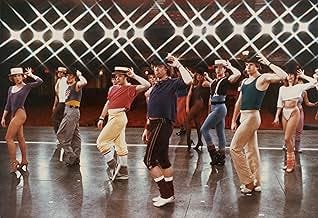In its second episode, the 2022 series Welcome to Chippendales pays homage to the classic musical A Chorus Line. While you may not recognize the name of the 1975 stage production, and its 1985 film adaptation, you’ve probably seen it referenced in the media somewhere. It’s most likely that you’ve already heard some of A Chorus Line’s music—many TV shows and movies use songs from it, such as MST3K, Family Guy, and, of course, Muppets Most Wanted.
The most commonly referenced song is the opening audition number—“I Hope I Get It.” In the linked YouTube video of A Chorus Line, the move that repeats from 6:07-6:15, the clap-pivot-turn, also appears in the Welcome to Chippendales audition choreography:
This points to how the fictional choreographer in the show, Nick De Noia, and the real choreographer of the show, Michelle Johnson, use elements of classic Broadway choreography from the 1970s and 1980s. This includes nods to the film version of A Chorus Line (1985), choreographed by Jeffrey Hornaday. Michelle Johnson says in the linked interview that one of the dancers on the TV show was an original Chippendales dancer, and she drew on his experience as well. (Another Welcome to Chippendales dancer, Brandon Leffler, starred in a production of A Chorus Line.) She also mentions how the actor playing Nick De Noia, Murray Bartlett, would use lines that she would say while teaching the choreography. His attention to how choreographers talk and move, and imitating that on screen, is one way that Welcome to Chippendales illustrates its love of dance.
There is some interesting overlap between Broadway choreography and classic Chippendales choreography, especially when both are adapted for another medium (film or TV). In addition to including some of the same basic steps, like the pivot turn, both are designed to be performed for an audience, on a stage. This is opposed to social dancing, which is more communal and less performative. On the screen, the camera can become the audience, and/or the scene can include an audience of extras.
An audience is a must for scenes that include lap dances. The intimacy of a dancer interacting with one audience member can be contrasted with staged movements. You aren’t doing the clap-pivot-turn in a lap dance. You’re turning around to show off various assets, but it’s not meant to be a movement that someone can see from the back of the theater, like on Broadway. You are moving in a smaller area, and your hands are usually on yourself or on the person you are performing for. Chippendales dancers are men who can do both—the Broadway jazz and the imitations of sex. I also once knew a Chippendoll, a female version of a Chippendale, who gave fun lap dances.
The Chorus Line dancers aren’t being paid to grind on customers like Chippendales dancers, nor are they staging lap dances, as in the movie and musical Magic Mike. The movie version of A Chorus Line includes a dancer accidentally leaping into the arms of the assistant choreographer, Larry, but he tells the dancer to take it down a notch—it’s a comical moment. A Chorus Line does frankly discuss both gay and straight sex, as well as features some sexy partner moments in songs like “Surprise Surprise.” However, the sexiness is between people on stage, not between dancers and audience members. The film version of A Chorus Line has only a couple audience members—Larry, the main choreographer, Zach, and his personal assistant, Kim. She is the only Black female named character with lines in multiple scenes.
In this way, Kim from the movie A Chorus Line can be compared with Astrid in the TV show Fringe. Fringe’s musical episode includes Astrid, played by Jasika Nicole (who has an extensive musical theater background), singing a few lines from “I Hope I Get It”: “I really need this job, please God I need this job, I’ve got to get this job.” The memorable, and ubiquitous, nature of these lines rests in the fact that A Chorus Line is a musical about labor and being a working class artist. Shows continually reference A Chorus Line because it explicitly voices the concerns of people who have to work to pay their bills and simply exist—people without generational wealth.
Not only am I a working-class writer and dancer, I will always have an intimate relationship with A Chorus Line’s music because I saw its composer, Marvin Hamlisch, in concert. My dad took me to this concert and various musicals when I was a teenager; we were living in Colorado when we saw Hamlisch live. Hamlisch joked about how someone sent him Loveland merch because he thought it was a great name for a town, and how he likes the name of a fancy car if anyone wants to send him one. Hamlisch died before my father died, and I was lucky to share that moment with two men who have now both passed. The music of A Chorus Line reminds me of my dad’s acceptance of the queer community and his love of the arts. He supported my dancing, writing, dating people of all genders, and doing other things that the dancers in A Chorus Line sing about. This is an emotional, and important, familial inheritance that doesn’t include generational wealth. My life will always include applying to jobs and singing “I hope I get it.”



